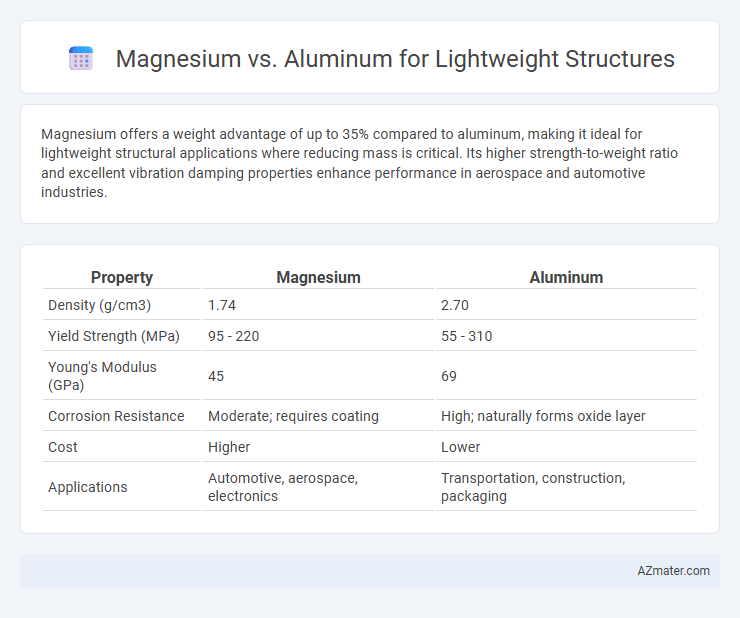Magnesium offers a weight advantage of up to 35% compared to aluminum, making it ideal for lightweight structural applications where reducing mass is critical. Its higher strength-to-weight ratio and excellent vibration damping properties enhance performance in aerospace and automotive industries.
Table of Comparison
| Property | Magnesium | Aluminum |
|---|---|---|
| Density (g/cm3) | 1.74 | 2.70 |
| Yield Strength (MPa) | 95 - 220 | 55 - 310 |
| Young's Modulus (GPa) | 45 | 69 |
| Corrosion Resistance | Moderate; requires coating | High; naturally forms oxide layer |
| Cost | Higher | Lower |
| Applications | Automotive, aerospace, electronics | Transportation, construction, packaging |
Introduction to Lightweight Structural Materials
Magnesium and aluminum are prominent lightweight structural materials extensively used in aerospace, automotive, and electronics industries due to their exceptional strength-to-weight ratios. Magnesium, the lightest structural metal, offers a density of approximately 1.74 g/cm3, significantly lower than aluminum's 2.70 g/cm3, enhancing weight reduction in high-performance applications. Both metals exhibit excellent machinability and corrosion resistance when properly alloyed, but magnesium's superior specific strength and damping capacity make it highly advantageous for vibration-sensitive lightweight structures.
Overview of Magnesium and Aluminum Properties
Magnesium offers a density of approximately 1.74 g/cm3, making it the lightest structural metal, while aluminum has a density of about 2.70 g/cm3, providing a balance of lightweight and strength. Magnesium exhibits higher specific strength and excellent damping capacity, beneficial for vibration-sensitive applications, whereas aluminum provides superior corrosion resistance and ease of fabrication. Both metals deliver high strength-to-weight ratios, but aluminum typically outperforms magnesium in terms of durability and availability for large-scale lightweight structural components.
Weight Comparison: Magnesium vs Aluminum
Magnesium has a density of approximately 1.74 g/cm3, making it about 33% lighter than aluminum, which has a density of around 2.70 g/cm3. This significant weight difference makes magnesium a preferred choice for applications requiring ultra-lightweight structures, such as aerospace and automotive industries. Despite its lower weight, magnesium alloys maintain sufficient strength for many structural applications, offering an optimal balance between weight reduction and material performance.
Strength and Durability Characteristics
Magnesium alloys offer a higher strength-to-weight ratio compared to aluminum, making them ideal for lightweight structures requiring enhanced performance without significant weight increase. While aluminum provides superior corrosion resistance and durability in harsh environments, magnesium's lower density contributes to significant weight savings but may require protective coatings to improve its longevity. For applications prioritizing strength and durability, aluminum alloys typically outperform magnesium in fatigue resistance and environmental stability, though advanced magnesium composites are closing this gap.
Corrosion Resistance and Longevity
Magnesium offers excellent lightweight properties but is more prone to corrosion compared to aluminum, which features a naturally forming oxide layer that enhances its corrosion resistance and longevity. Aluminum alloys exhibit superior durability in harsh environments, making them ideal for applications requiring extended service life and minimal maintenance. Corrosion resistance treatments for magnesium can improve performance, but aluminum remains the preferred choice for long-term structural integrity in lightweight construction.
Machinability and Fabrication Ease
Magnesium offers superior machinability compared to aluminum due to its lower density and softer nature, reducing tool wear and machining time. Fabrication of magnesium is generally easier, benefiting from its excellent thermal conductivity and casting properties, which enhance mold filling and shape accuracy. Aluminum, while harder, provides better corrosion resistance and strength-to-weight ratio, making it suitable for more demanding structural applications but often requiring more complex machining processes.
Cost and Availability Factors
Magnesium offers a cost-effective solution for lightweight structures due to its abundance and lower production energy requirements compared to aluminum. While aluminum is more widely available globally, its higher refining and processing costs increase overall expenses in construction and manufacturing. The choice between magnesium and aluminum hinges on balancing upfront material costs against supply chain consistency and production scalability.
Environmental Impact and Sustainability
Magnesium offers a lower carbon footprint compared to aluminum due to its lower energy-intensive extraction and processing methods, contributing to reduced greenhouse gas emissions in lightweight structural applications. While aluminum is more abundant and highly recyclable with established recycling infrastructure, magnesium recycling rates remain lower, posing challenges for circular economy efforts. Balancing the environmental benefits of magnesium's lighter weight with aluminum's recyclability is crucial for sustainable lightweight structure development.
Common Applications in Industry
Magnesium alloys are widely utilized in automotive and aerospace industries for lightweight structural components due to their superior strength-to-weight ratio and excellent vibration damping properties. Aluminum alloys dominate sectors like construction, transportation, and packaging because of their corrosion resistance, ease of fabrication, and cost-effectiveness. Both metals serve critical roles in lightweight design, with magnesium preferred for performance-critical applications and aluminum favored for versatile, large-scale manufacturing.
Choosing the Right Material for Lightweight Structures
Magnesium offers superior weight reduction with a density of around 1.74 g/cm3, significantly lighter than aluminum's 2.70 g/cm3, ideal for lightweight structural applications requiring enhanced fuel efficiency. Aluminum provides higher corrosion resistance and better ductility, making it suitable for environments exposed to moisture and requiring formability. Selecting between magnesium and aluminum depends on balancing factors such as strength-to-weight ratio, environmental conditions, and cost-effectiveness for optimal lightweight structure performance.

Infographic: Magnesium vs Aluminum for Lightweight Structure
 azmater.com
azmater.com